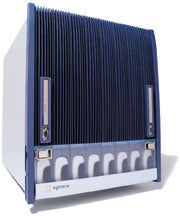
 |
Egenera is something of an enigma in this era of hardware vendor
consolidation: an independent player in a tough market. To make matters
worse, the company’s chosen battleground is owned by two companies. HP Inc.
of Palo Alto, CA and IBM Corp. of Armonk, NY, account for about three
quarters of the blade sales, according to John Enck, an analyst at Gartner
Inc. of Stamford, Conn.
How is independent blade vendor Egenera surviving in a market overshadowed by IBM and HP? Analysts say technical excellence and cutting-edge features.
So how is it that Egenera, Inc. of Marlboro, MA, has survived where other
pioneers like RLX, acquired by HP four years ago, fell by the wayside?
“Egenera continues to demonstrate technical excellence in its blade server
hardware products,” said Enck.
This excellence comes in the form of its BladeFrame products, which make
use of higher-powered AMD and Intel chips. The company further complements its
offerings with high availability features and an emphasis on
virtualization.
“Egenera is a leader in server infrastructure virtualization with over 300
enterprise deployments and software proven in production for more than seven
years,” said Dick Csaplar, senior product manager at Egenera. “We believe
that the next phase of virtualization in the data center is well under way
and as such, blades remain the form factor of choice for many virtual machine
(VM) deployments.”
As the IT world begins to gain a better understanding of the perils of VM
sprawl, Egenera senses an opportunity. Csaplar said that the increasing
levels of hypervisor-based server virtualization in the enterprise are
driving IT to seek out solutions for how to manage hundreds or in many cases,
thousands of virtual machines. This necessitates a means of reducing the
management complexity — in particular, the ability to cope with a blended
environment of virtual and physical resources from one pane of glass.
“While virtualization continues to expand, not all applications can or
should be hosted on VMs — so the physical world (blades or otherwise) remains
as important as it’s ever been,” said Csaplar. “The focus now must be on the
management of both types of resources to ensure a responsive business.”
He feels that Egenera leads the pack in terms in terms of monitoring
virtual and physical servers from one place. The company backs that up with
plenty of disaster recovery (DR) and high availability features.
At the forefront of this strategy is Egenera’s Processing Area Network
(PAN) Manager software. As well as eliminating resource-intensive systems
administration tasks, PAN Manager creates pools of compute, storage and
network resources that can be allocated as needed. The benefits are said to
be up to 75 percent lower TCO, server provision in two minutes and lights out
management. PAN Manager also delivers logical resource partitioning,
multi-frame management from one domain, online server configuration changes,
chargeback and other services
“PAN is not optional in our integrated BladeFrame systems, and is the core
of our business value with customers,” said Csaplar. “PAN Manager provides a
single management interface that allows for advanced virtual and physical
server management features such as N+1 failover pools, easy disaster
recovery, extremely fast setup (time to market) and backup, reduced
administrative expenses and virtual environment management.”
Egenera offers a choice of chassis. The ES is the smaller of two. It has
enough slots for six blades whereas the EX can accommodate 24. They both use
the exact same version of PAN Manager software so the features are identical.
According to Egenera, the ES is mostly used for rack deployment in development
environments or in SMB settings, whereas the EX is targeted more at
mission-critical data center applications.

Its blades are called pBlades (processing blade). They come with a few
possible variations. Four-processor models include quad-core Intel Xeon x7350
(2.93 GHz) with 32, 64 and 96 GB memory and dual-core AMD Opteron 8220 SE
(2.8 GHz) with 32 and 64 GB memory. On the two-processor side, there are
quad-core Xeon E5410 (2.33 GHz) and Xeon E5450 (3.0 GHz) with 8, 16 and 32 GB
memory, as well as dual-core Opteron 2220SE (2.8GHz) with 16 GB memory.
“We stay current with the latest CPU offerings of both AMD and Intel,”
said Csaplar. “We have also been increasing the average memory configuration
to support the rising deployment of virtual environments. We are still the
only blade vendor to support 96 GB of memory and 4 CPUs in a 1U form
factor.”
Moving forward, you can expect Egenera to be quick on the uptake of
six-core CPUs when these are released by Intel. The company will also
continue to focus on reduced power requirements. The need to cut costs for
power and space cuts across all industries and customers, said Csaplar.
Egenera sets pricing based on the number of blades, types of blades and
the different software features. As such, the company doesn’t publish pricing
for its systems as each is a custom installation. pBlades themselves start at
around $5,000 for two Intel E5410 CPUs with 8 GB RAM. At the high end, four
Intel x7350 CPUs with 96 GB memory costs $43,700.
Egenera recently began offering its PAN Manager virtualization software on
third-party hardware platforms, including Dell and Fujitsu Siemens Computers.
Csaplar noted that other platforms will be added over time. For now, only
Dell and Fujitsu Siemens will be shipping PAN Manager on their hardware.
So will all this be enough to keep the big two blade vendors at bay? Time
will tell.
“The problem for Egenera is that mainstream vendors are now producing
products that users often consider ‘good enough’ for data center use,” said
Enck. “Furthermore, entry into the software market through partnership with
Dell will challenge Egenera to show it can be successful in both hardware and
software markets – something RLX was unable to do.”
The BladeFrame EX
and ES Close Up
| Name | BladeFrame EX |
BladeFrame ES |
| Vendor | Egenera | Egenera |
| Platform | X86 | X86 |
| Dimensions | 82″ x 24″ x 30″; 1000lbs | 23″ x 18″ x 30″; 280lbs |
| Processor Details | 4 Processor Models: Quad-core Intel (2.93GHz x7350) with 32, 64 and 96GB memory, Dual-core AMD (2.8GHz 8220SE) with 32 and 64GB memory 2 Processor Models: Quad-core Intel (2.33 E5410 & 3.0GHz E5450) with 8, 16 and 32GB memory, Dual-core AMD (2.8GHz 2220SE) with 16GB memory, All memory ECC |
4 Processor Models: Quad-core Intel (2.93GHz x7350) with 32, 64 and 96GB memory, Dual-core AMD (2.8GHz 8220SE) with 32 and 64GB memory 2 Processor Models: Quad-core Intel (2.33 E5410 & 3.0GHz E5450) with 8, 16 and 32GB memory, Dual-core AMD (2.8GHz 2220SE) with 16GB memory, All memory ECC |
| Hard Drives | None – all storage is external | None – all storage is external |
| Operating Systems | Windows, Red Hat Linux, SuSE Linux, Solaris 10, VMware VI3, XenServer, ORACLE Enterprise Linux |
Windows, Red Hat Linux, SuSE Linux, Solaris 10, VMware VI3, XenServer, ORACLE Enterprise Linux |
| Configuration Options | Egenera sets pricing based on the number of blades, types of blades and the different software features. pBlades start at around $5,000 for two Intel E5410 CPUs with 8 GB RAM. Four Intel x7350 CPUs with 96 GB memory costs $43,700. |
Egenera sets pricing based on the number of blades, types of blades and the different software features. pBlades start at around $5,000 for two Intel E5410 CPUs with 8 GB RAM. Four Intel x7350 CPUs with 96 GB memory costs $43,700. |
| GA | Now Available | Now Available |
| Warranty | One year | One year |
Property of TechnologyAdvice. © 2025 TechnologyAdvice. All Rights Reserved
Advertiser Disclosure: Some of the products that appear on this site are from companies from which TechnologyAdvice receives compensation. This compensation may impact how and where products appear on this site including, for example, the order in which they appear. TechnologyAdvice does not include all companies or all types of products available in the marketplace.